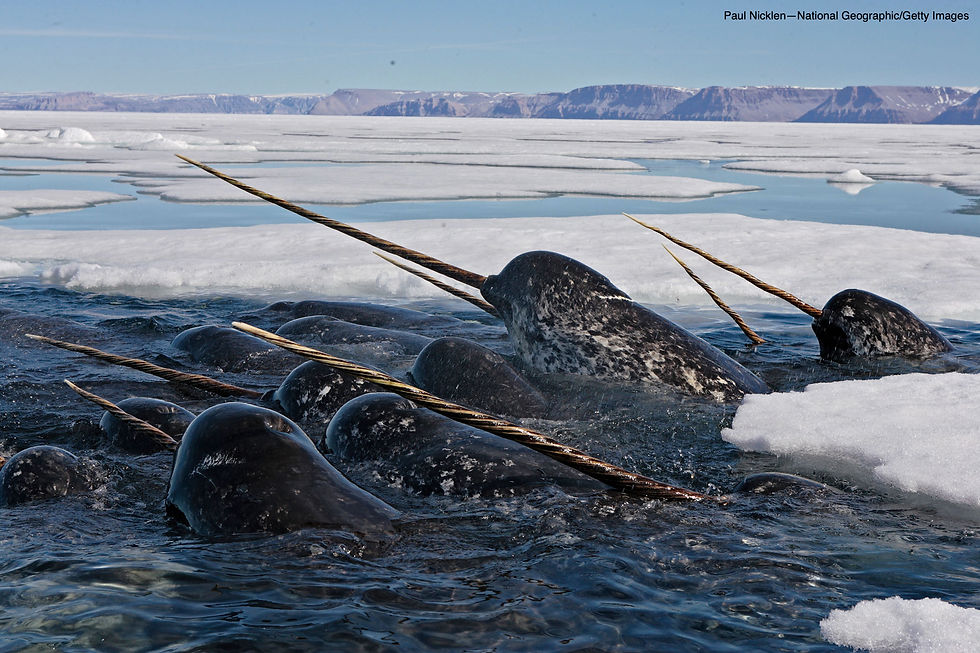Narwhal Have got 99 Problems, but the Effects of Low Genetic Diversity Ain’t One
- NWong
- May 5, 2019
- 3 min read

The ability to adapt or adaptive potential is often thought of in the form of genetic diversity. If a population has high genetic diversity, it is assumed that the population could contain a good range of phenotypes (the set of observable characteristics of an individual resulting from the interaction of its genotype with the environment) which can allow for adaptation, say to something like global warming for example.
Thinking oppositely now, you would think that for a population to have low genetic diversity it is usually a bad thing – and in most cases it is. Interestingly, the majestic unicorn of the sea, the Narwhal (Monodon monoceros) has recently been shown that some populations fair pretty well despite having low genetic diversity.
The narwhal is the most specialized and iconic endemic Arctic cetacean. This toothed-whale is well known for its elongated tusk that protrudes from its upper jaw and deep diving capabilities. They are distributed in the Arctic seas bordering the North Atlantic and make annual migrations between coastal summering grounds and offshore ice-covered wintering grounds. Low genetic diversity is often the result of inbreeding or small population sizes, but the narwhal population data does not fit these explanations. Low levels of genetic diversity have been found across several narwhal populations using mitochondrial DNA and microsatellites, despite narwhal abundance being relatively high. In fact, the global population is estimated at 170,000 which has recently been enough to change their official conservation status from “near threatened” to “least concern”.
To investigate the possible reasons for this low narwhal genetic diversity Danish researchers assembled and annotated a nuclear genome from a narwhal from West Greenland… i.e. sequenced its genome. This publication is in press with iScience. They assembled 2,350,959,615 base pairs (bp) of the narwhal nuclear genome (humans have approximately 3 billion bp). Without the excruciating details, using software they investigated the genome-wide levels of genetic diversity. Please see the paper for detailed findings, but basically found that the low diversity did not arise by recent inbreeding, but rather has been stable over an extended evolutionary timescale. The analyses show that the current large global abundance most likely arose due to rapid population growth around the start of the Last Glacial Maximum ~115,000 years ago and that genetic diversity may not have had time to increase accordingly.
Their genetics also suggest that prior to the start of the last glacial period, the narwhal population had been slowly declining for about a million years. Looking back historically maybe this previous gradual decline might explain why the lack of diversity does not seem to be a problem for the extant narwhal populations. While a large population die off could mean the loss of important genetic variations are lost, the narwhals’ slow decline could have allowed them to preserve the vital genetic diversity.
This IUCN reclassification from “near threatened” to “least concern” did not take into account the genetic diversity and the future genetic adaptability of the narwhal. Therefore, despite the downgrade in conservation status, it should still be considered one of the most vulnerable Arctic marine mammals to ongoing rapid climate changes and its limited distribution. How well the narwhal fair in the future likely depends how fast the Arctic climate continues to change.
Please see the following link for the Open Source article from iScience:
Westbury et al., (In Press) Narwhal Genome Reveals Long-Term Low Genetic Diversity despite Current Large Abundance Size, iScience (2019), https://doi.org/10.1016/j.isci.2019.03.023





Comments